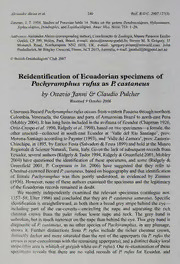
Reidentification of Ecuadorian specimens of Pachyramphus rufus as P-castaneus PDF
Preview Reidentification of Ecuadorian specimens of Pachyramphus rufus as P-castaneus
— AlexandreAleixoetal. 246 Bull. B.O.C. 2007127(3) Zimmer, J. T. 1934. Studies ofPeruvian birds 14. Notes on the generaDendrocolaptes, Hylexetastes, Xiphocolaptes,Dendroplex,andLepidocolaptes Amer. Mus. Novit. 753: 1-26. . Addresses:AlexandreAleixo(correspondingauthor),CoordenacaodeZoologia,MuseuParaenseEmilio Goeldi, CP 399, Belem, Para, Brazil, e-mail: [email protected]. Steven M. S. Gregory, 35 Monarch Road, Northampton NN2 6EH, UK, e-mail: [email protected]. John Penhallurick,86BingleyCrescent,Fraser,ACT2615,Australia,e-mail:[email protected] ©BritishOrnithologists'Club2007 Reidentification ofEcuadorian specimens of Pachyramphus rufus as P. castaneus & by Ottavio Janni Claudio Pulcher Received9 October2006 CinereousBecardPachyramphusrufusoccursfromwesternPanamathroughnorthern Colombia, Venezuela, the Guianas andparts ofAmazonian Brazil to north-east Peru (Mobley2004). Ithas longbeenincludedinthe avifaunaofEcuador(C—hapman 1926, Ortiz-Crespoe—tal. 1990,Ridgelyetal. 1998),basedontwospecimens afemale,the other unsexed collected in south-east Ecuador at 'Valle del Rio Santiago', prov. Morona-SantiagoaccordingtoPaynter(1993), and 'ValledelZamora',prov. Zamora- Chinchipe, in 1895, by Enrico Festa (Salvadori & Festa 1899) andheld atthe Museo Regionaledi ScienzeNaturali,Turin, Italy. Giventhelackofsubsequentrecords from Ecuador, severalauthors(Ridgely&Tudor 1994,Ridgely&Greenfield2001,Mobley 2004) have questioned the identification ofthese specimens, and some (Ridgely & Greenfield 2001, P. Coopmans in litt. 2006) have suggested that they refer to Chestnut-crownedBecardP. castaneus,basedonbiogeographyandthatidentification of female Pachyramphus was then poorly understood, as evidenced by Zimmer (1936). However, none ofthese authors examined the specimens and the legitimacy ofthe Ecuadorian records remained in doubt. We recently independently examined the relevant specimens (catalogue nos. 1357-58; Elter 1986) and concluded that they are P. castaneus saturatus. Specific identification is straightforward, as—both show a broad grey stripe behind the eye including part of the ear-coverts encircling the nape and separating the rich chestnut crown from the paler rufous lower nape and neck. The grey band is unbroken, but is much narrower on the nape than behind the eye. This grey band is diagnostic ofP. castaneus, as no other species ofPachyramphus, in any plumage, shows it. Further distinctions from P. rufus include the richer chestnut crown, distinctly darker and more saturated than the rest ofthe upperparts (in P. rufus the crown is near-concolorous with the remainingupperparts), andadistinctduskyloral stripe (this area is whitish orgreyish white onP. rufus). Ourre-examinationofthese specimens reveals that there are no valid records of P. rufus for Ecuador, and OttavioJanni& ClaudioPulcher 247 Bull. B.O.C. 2007127(3) & underlines the importance of avian collections held in Italy (Violani Barbagli 2003). Acknowledgements WethankGiovanni Boano,ErmannoDeBiagi, ElenaGavettiandLisaLevi forprovidingaccesstothe specimens, andthelatePaulCoopmansandRobertRidgelyforencouragingustoexaminethematerial andpublishthisnote. References: Chapman,¥. M. 1926.ThedistributionofbirdlifeinEcuador.Bull.Amer. Mus. Nat. Hist. 55: 1-784. Elter O. 1986. La collezione ornitologica del Museo di Zoologia dell'Universitd di Torino. Museo Regionaledi ScienzeNaturali,Turin. Mobley,J.A.2004.CinereousBecardPachyramphusrufus.R455indelHoyo,J.,Elliott,A.&Christie, D.A. (eds.)Handbookofthebirdsoftheworld,vol. 9. LynxEdicions, Barcelona. Ortiz-Crespo,F.,Greenfield,RJ. &Matheus,J. C. 1990.AvesdelEcuador, continenteyarchipelagode Galapagos. FundacionEcuatorianadePromocionTuristica&FundacionOrnitologicadelEcuador, Quito. Paynter, R. A. 1993. OrnithologicalgazeteerofEcuador. Second edn. Mus. Comp. Zool., Cambridge, MA. Ridgely,R. S. &Greenfield,P. J. 2001. ThebirdsofEcuador,vol. 1. CornellUniv. Press,Ithaca,NY. Ridgely,R. S.,Greenfield,P.J.&GuerreroG,M. 1998. UnalistaanotadadelasavesdelEcuadorcon- tinental. FundacionOrnitologicadel Ecuador,Quito. Ridgely,R. S. &Tudor,G. 1994. ThebirdsofSouthAmerica,vol. 2. Univ. ofTexasPress,Austin. Salvadori,T&Festa,E. 1899.ViaggiodelDr.EnricoFestanell'Ecuador.Parteseconda—passeresclam- atores.Boll. Mus. Zool.Anat. Comp. Torino 15(362). Violani,C. G. &Barbagli,F. 2003.Theinternational importanceofbirdcollectionsinItalianmuseums. Bull. Brit. Orn. CI. 123: 143-152. Zimmer,J.T. 1936. StudiesofPeruvianbirds.No.24.NotesonPachyramphus,Platypsaris, Tityra,and Pyroderus.Amer. Mus. Novit. 894. Addresses: Ottavio Janni, Via Monte Muto 29, 81016 Piedimonte Matese (CE), Italy, e-mail: [email protected]. Claudio Pulcher, Museo Regionale di Scienze Naturali, Via Giolitti 36, 10023 Turin,Italy,e-mail: [email protected] ©BritishOrnithologists'Club2007 The correct name ofthe Guianan Toucanet: Selenidera culik (Wagler) not 5. piperivorus (Linnaeus) by MichaelWalters Received28June 2007 Pacheco & Whitney (2006) sought to change the names ofthree Neotropical birds. Two ofthese may be addressed at a later stage, but this note discusses the case of the bird currently known as Selenidera culik (Wagler, 1827), which Pacheco & Whitney soughtto replace withRamphastospiperivorus Linnaeus, a name rejected
